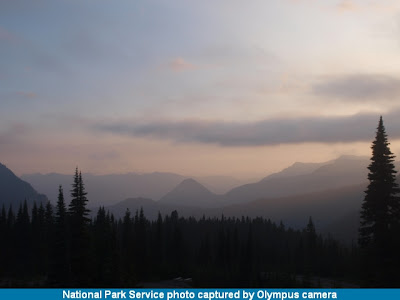
The National Park Service conducted public meetings for the last version of the Environmental Assessment report for the Carbon River corridor Tuesday through Thursday in Buckley, Tacoma and Seattle, respectively. You can get a copy of the report from the NPS Park Planning
Website. The meeting in Tacoma lasted for over two and a half hours, half the NPS staff presentation and half the public comment.
The NPS is offering five alternatives for the Carbon River corridor from the entrance to the Ipsut Campground. All of this stems from a series of floods in the 1990's (1990 and 1996) and the last decade (2006 and 2008). The alternatives range from the do nothing to the reconstruction of the vehicle road to Chenius (Falls/Creek) and to constructing a new trail from the entrance to Ipsut Creek campground. The NPS has selected one which they propose as the optimium.
Ok, after the presentation and public discussion at the Tacoma meeting, what does it mean? Well, for one the Carbon River can't be maintained over the entire ~5 mile length. There are several places where the road and river occupy the same space, and there are several places the river is higher than the adjacent river. In short, it's very expensive, and will be after each major flood, to keep the road it's length.
The problem is that the road is part of the National Historic Landmark District (NHLD) for the NP, and every effort is supposed to be made to maintain the road. But it's just not cost effective. The NPS has selected the alternative that maintains the road for 1.2 miles into the NP, to the Old Mine trail, after which the road will be a hiking trail. It's not the cheapest nor necessary the best, but the optimum for everyone for the available money.
I leave it to the NPS and reporters who will present the objective view of the alternatives, the public comments and the preferred alternative. Personally I liked the new wilderness trail, moving the facilities near the entrance and at Ipsut Creek campground and constructing a new trail south of the river at higher ground off the river valley out of the way of the river and floods. This would make it a really year around trail out of range from floods.
The problem is that the trail-only alternatives which many hikers prefer doesn't help the disabled or people who can't hike, or people wanting to drive into the NP. The second problem is the distance from the entrance to the Ipsut campground, long the destination of car trips for a picnic or dayhike until the winter 2006 floods. It was the shortest distance to the Carbon Glacier. Now it's a ~5 mile one way hike/bike trip just to get to the Ipsut Creek campground, clearly out of reach for many people.
There were several older people, remembering I'm 61 and a day hiker, wanted the NPS to rebuild and maintain the road to the Ipsut Creek campground at any cost, and all because it's what they have always done, or did until 2006, and now miss it. All the reality, some in the presentation by the NPS staff geologist and landscape architect and some in the comments by the attending public, including a civil engineer and myself (retired hydrologist), couldn't convince them it's not realistic let alone practicable.
In the end it was a excellent presentation and interesting discussion. I'll take the alternative they've chosen, although I favor a trail-only one (alternative 1, do nothing, and really alternative 5, new trail). But the NPS' alternative is the best compromise where a road can be maintained with the least work for the least cost. Any more road will encounter problems with the river where there will always be a risk of being destroyed by floods.
Even the road in the alternative the NPS proposes still has problems with the river if any significant flood changes the hydrology, hydraulics and geomorphology of the river and river valley over that section. Then they face the other alternatives of abandoning the road altogether, which will likely be the eventual result and solution. Rivers are like that, sorting their own route in their river valley, regardless of what we want to build.
Anyway, there will be some news stories on it as well as the NP's public comment period (above Website) for the 45 days before either the preferred one is chosen by senior NP managers or they go back to the drawing board to one of the other ones or a new one. Then the NP will need to get the money for the work in the next few fiscal years. We hope Congress actually does something.
I wish them the best, especially in the current political environment of Congress. The Carbon River corridor needs a solution.




























